It looks like you're using an Ad Blocker.
Please white-list or disable AboveTopSecret.com in your ad-blocking tool.
Thank you.
Some features of ATS will be disabled while you continue to use an ad-blocker.
share:
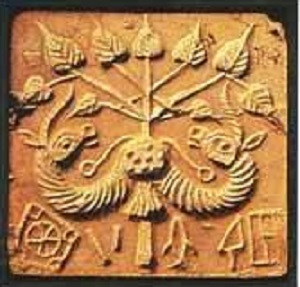
If red bull gives you wings then Soma gives you horns. Above is the seven branched Soma plant growing out of two buffalo headed horns. Horns in antiquity was the symbol of enlightenment and those who drink Soma are horned ones.

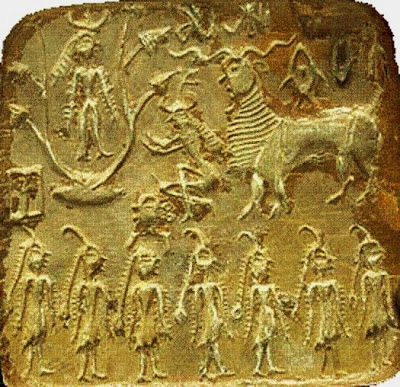
originally posted by: Kantzveldt
a reply to: Byrd
Technically the Mesopotamian seals are all Jemdet Nasr period that predates the Sumerian Dynastic, of seals found relating to that period i would say around 60% relate to the subject matter involved here, seated woman with pony tail/jar and two cups/association with bull and spider motif, they're also found very widely distributed centred upon Uruk through. Iran, Bahrain and the head of the gulf, suggesting this related to an important and widely traded commodity of that period.
But what's the context of the seals? Are those the complete seals or are they like the ones shown by Velikovsky, with parts missing?
What's the context of the finds? What else were they placed with (temple foundation deposit? Grave goods of clergy? shop area?)
There's extensive evidence for trade contact with Mesopotamia and the Indus valley and the evidence for Indus valley/Meluhhan communities in Southern Mesopotamia at the trading port of Nigin, were there also seems to be influence with regards to the local Pantheon.
I agree that it's not impossible and that there's likely enclaves in each area where these deities were worshiped.
I would also suggest that the fish people cult of Nigin had correspondence in Indus valley culture, also of course there are informed considerations as to the individual signs of Indus valley script;
From what I'm reading it seems as if only one or two hold to this view and the rest consider it incorrect.
I would then consider the Jemdet Nasr seals and those of the Indus valley as very closely related at an early date, it's something of a mystery that all those seal types disappear into the Dynastic period.
If they're not found in the same place and in the same context, the relation is not possible to prove. For example, they also had snakes in their art, but unlike the Egyptians, snakes were not divided into two classes and did not occupy the same kinds of position in the religion.
a reply to: Byrd
Of course the seal impressions are complete and they're generally the singular repeated motif anyway not elaborate scenes, in terms of context i spent considerable time collecting all the associated examples as seen here and nobody had done this before, taken an interest in this genre itself, all academia says about these in terms of brief identifications is for example woman with pony tail doing something or other, the pouring jar and two cups is also standard identification, so i'm the only one who attempted any sort of contextual explanation for them, and in terms of context of finding they can turn up in any area of a site like all seals.
A similar sort of situation prevails for specialist interest in the Pantheon of Lagash state or Meluhhan links with Nigin, i could name the handful of people researching in that area, it's not like everybody else disagrees with them or could offer an alternate opinion, so yes there are very few people making this sort of case.
a reply to: zinc12
Yes you're right those seven fig leaves relate to the seven spiritual qualities of Soma, and there's also the two lower leaves which involved considerable complexity, in those days one did not simply sit under a fig tree to gain enlightenment of course.
Of course the seal impressions are complete and they're generally the singular repeated motif anyway not elaborate scenes, in terms of context i spent considerable time collecting all the associated examples as seen here and nobody had done this before, taken an interest in this genre itself, all academia says about these in terms of brief identifications is for example woman with pony tail doing something or other, the pouring jar and two cups is also standard identification, so i'm the only one who attempted any sort of contextual explanation for them, and in terms of context of finding they can turn up in any area of a site like all seals.
A similar sort of situation prevails for specialist interest in the Pantheon of Lagash state or Meluhhan links with Nigin, i could name the handful of people researching in that area, it's not like everybody else disagrees with them or could offer an alternate opinion, so yes there are very few people making this sort of case.
a reply to: zinc12
Yes you're right those seven fig leaves relate to the seven spiritual qualities of Soma, and there's also the two lower leaves which involved considerable complexity, in those days one did not simply sit under a fig tree to gain enlightenment of course.
edit on
Kam930261vAmerica/ChicagoSunday1830 by Kantzveldt because: (no reason given)
originally posted by: Kantzveldt
a reply to: Byrd
Of course the seal impressions are complete and they're generally the singular repeated motif anyway not elaborate scenes, in terms of context i spent considerable time collecting all the associated examples as seen here and nobody had done this before,
What I was asking is, "where and when are each of these seals from."
I am also skeptical that the first image relates to soma in any way - the hanging fruit suggest another interpretation, and the figures appear to be grinding grain. While that might refer to"soma" it could just as well refer to any other pounded substance such as
Now, I'm not a very knowledgeable about Mesopotamia, but I did find in Wikipedia the following quote about soma:
In 1989 Harry Falk noted that, in the texts, both haoma and soma were said to enhance alertness and awareness, did not coincide with the consciousness altering effects of an entheogen, and that "there is nothing shamanistic or visionary either in early Vedic or in Old Iranian texts", (Falk, 1989)
source
I assume that Falk's observation is correct and would note that this also eliminates opium as a candidate for "soma."
In looking further into literature, I came across this nice PDF of a recent ethnobotanical study of soma. There are a number of things that eliminate the opium poppy in my mind.
For instance, the Rigveda says that the twigs of the plant are crushed in a mortar (the juice is collected in a cowhide) and that they soaked the stems in water in order to extract more juice. This source also says "n. The drink recipe so prepared, was sweet smelling and neither hallucinogenic nor intoxicating; rather acting stimulant that kept the drinker awake and alert all through."
Secondly, the plant description does not match what's given in the Vedas:
" As a general characteristic, all the Soma varieties were furnished with 15 leaves, the character contradicting to the Vedic description that the plant was leafless. However, all the varieties had possessed a bulb, a creeper like morphology and secreted milky juice. Interestingly, the emergence of 15 leaves in all these 24 varieties,
one by one daily keeping pace with the Tithis (lunar days) of bright fortnight (Ssukla Paksha) and becoming well furnished with 15 leaves on full-moon day (Poornami). Subsequently, they lose the leaves one by one in the same order of
Tithies of dark fortnights (Krushna Paksha) and finally on no-moon day (Amaavaasyaa) remained
in the form of a leafless stump "
Although the 'gaining leaves and then losing them' may sound impossible, here in Texas we have a plant that does that - the Trout Lilly - that emerges in February-ish, puts on leaves and then a bloom and then sheds leaves and vanishes within the space of a month. They are tuberous plants and spread in a creeper type fashion... and no, i'm not suggesting in the least that this is Soma.
So I'm not seeing a correspondence here between opium, soma, and the Babylonian deities called Annunaki.
a reply to: Byrd
Your quote is incorrect with regards to no visionary experience, how would you describe transforming into the Bull of Heaven and travelling there in a stream of consciousness, as the quotes in the OP detail, and speaking of such perhaps some only see what they want to see, as from the article you linked to;
There are any number of suggestions of what was involved and i'm sure that goes right back to post-Vedic period, that the tradition was lost with regards to making the Soma safe through admixture with other plant extracts, the above would be an example of the very unsafe.
Also from the article Soma as a constellation and luminous species; Soma as bird, the first image in the OP is not a seal it is an Indus valley plaque specific purpose unknown, but it shows the walking bird which in Mesopotamia related to that beneath Orion known as Ka-Ka, and which related to riding high in joy, were Hul Gil/Opium was the plant of joy in transaltion, those aren't fruit you're seeing they're containers hanging from a branch, the woman on the right probably relates to what appears to be a water pump and is thus pouring fresh water for the refinement process while the seated figure appears to be actually refining or filling a container.
Beneath the tree is seen a deer, there are parallels in Indo-European vulture were the deer reclines beneath a tree from which a bag hangs, for example below is considered to relate to the myth of Telepinu from the Hittites.
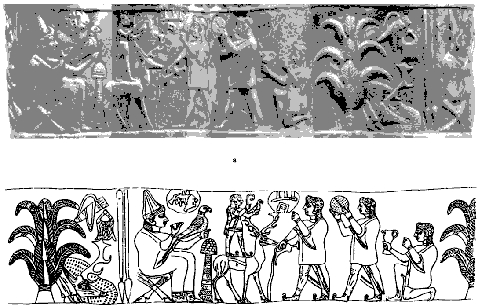
The only clarification necessary with regards to the Mesopotamian seals is that they're Jemdet Nasr and found widely distributed, meaning also that they predate the Indus valley plaques but i don't draw much conclusion from that as i think they had earlier common connection, that Uruk did not greatly influence the development of Indus valley culture.
Your quote is incorrect with regards to no visionary experience, how would you describe transforming into the Bull of Heaven and travelling there in a stream of consciousness, as the quotes in the OP detail, and speaking of such perhaps some only see what they want to see, as from the article you linked to;
The Soma drinker should prick the bulb of the plant with a golden needle and collect a hand-full (Anjali) measure of milky exudate in a golden or silver vessel. This juice should be gulped in one sip without testing it and after that should throw away the remnants into water
There are any number of suggestions of what was involved and i'm sure that goes right back to post-Vedic period, that the tradition was lost with regards to making the Soma safe through admixture with other plant extracts, the above would be an example of the very unsafe.
Also from the article Soma as a constellation and luminous species; Soma as bird, the first image in the OP is not a seal it is an Indus valley plaque specific purpose unknown, but it shows the walking bird which in Mesopotamia related to that beneath Orion known as Ka-Ka, and which related to riding high in joy, were Hul Gil/Opium was the plant of joy in transaltion, those aren't fruit you're seeing they're containers hanging from a branch, the woman on the right probably relates to what appears to be a water pump and is thus pouring fresh water for the refinement process while the seated figure appears to be actually refining or filling a container.
Beneath the tree is seen a deer, there are parallels in Indo-European vulture were the deer reclines beneath a tree from which a bag hangs, for example below is considered to relate to the myth of Telepinu from the Hittites.

The only clarification necessary with regards to the Mesopotamian seals is that they're Jemdet Nasr and found widely distributed, meaning also that they predate the Indus valley plaques but i don't draw much conclusion from that as i think they had earlier common connection, that Uruk did not greatly influence the development of Indus valley culture.
edit on Kpm930261vAmerica/ChicagoSunday1830 by Kantzveldt because: (no reason
given)
Will answer a few things and return for more later.
The article did mention the bulb and I did see it. The plants referenced in the article also have bulbs and milky sap. Opium is not the only plant that has this attribute (and some of the descriptions of the plant that provides the soma do not match the opium poppy.)
originally posted by: Kantzveldt
... and speaking of such perhaps some only see what they want to see, as from the article you linked to;
The Soma drinker should prick the bulb of the plant with a golden needle and collect a hand-full (Anjali) measure of milky exudate in a golden or silver vessel. This juice should be gulped in one sip without testing it and after that should throw away the remnants into water
The article did mention the bulb and I did see it. The plants referenced in the article also have bulbs and milky sap. Opium is not the only plant that has this attribute (and some of the descriptions of the plant that provides the soma do not match the opium poppy.)
edit on 18-9-2016 by Byrd because: (no reason given)
originally posted by: Kantzveldt
The only clarification necessary with regards to the Mesopotamian seals is that they're Jemdet Nasr and found widely distributed, meaning also that they predate the Indus valley plaques but i don't draw much conclusion from that as i think they had earlier common connection, that Uruk did not greatly influence the development of Indus valley culture.
Are you sure that your source is accurate?
I went through the entire Jemdet Nasr seals at CLDI (I hope that will come up correctly) and the seals there (with provenance) don't look ANYTHING like the seal impressions you've posted. An archaeological blog describes the Jemdet Nasr seals as "squat and plain" - a description that I'd certainly agree with. A pair of purported Jemdet Nasr seals for sale are here; again,these are in line with the published description (flat and plain; "marks" made by drills.)
I'm not seeing them among the cylinder seals at the Met Museum.
So now I'm curious - what era are they from and where were they found and in what context?
(edited to add)
The location and context makes a HUGE difference in the interpretation. If they're part of a temple foundational deposit, then these were sacred things themed to the needs of the temple. If they were found in a rubbish pit, it could be something discarded by the household or thrown there by robbers. If found in a tomb, it may relate to the lands held by the tomb owner.
I know this information is out there somewhere but the first step is to find out where they are and what they're said to be.
edit on 18-9-2016
by Byrd because: (no reason given)
a reply to: Byrd
These aren't examples of Jemdet Nasr cylinder seals you linked to, here are some examples from private collections, the first indicates the sites were found, Tell Asmar and Tell Agrab;
Example 1
Example 2
Example 3...from the Met
Example 4...the Met
Example 5...the Met
The description given;
At least having looked for yourself you should now appreciate that i sourced some very fine and rare examples no...?


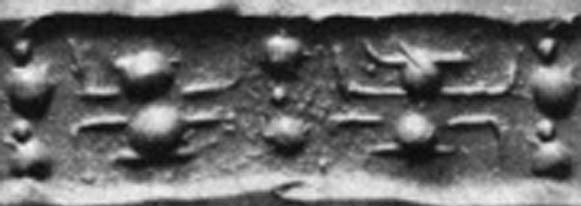

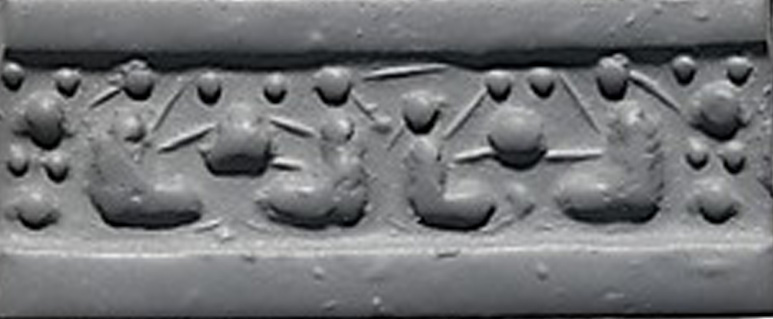


[
These aren't examples of Jemdet Nasr cylinder seals you linked to, here are some examples from private collections, the first indicates the sites were found, Tell Asmar and Tell Agrab;
Example 1
Example 2
Example 3...from the Met
Example 4...the Met
The modern impression of the seal is shown so that the entire design can be seen. The imagery on this seal depicts a figure squatting on a platform being served by two "pigtailed" figures, one sitting behind her and the other holding a vessel. A fourth figure sits on the ground line with arms outstretched to clasp the handle of a large vessel. Above this figure is a large arc, which may be a covering or may be an inverted quadruped with an elongated tail. The rest of the field is filled with vessels of two types. The predominant vessel, of which there are five, is depicted with one large round drill mark for the body and two smaller drill marks on top and bottom. In addition, there are two more small vessels or containers of unknown type resting on the ground line of the seal. They are formed with triangular bodies and two almost wing-like loops sprouting from their tops.
Example 5...the Met
The description given;
This small seal may depict female workers with pigtails seated on mats, perhaps engaged in the production of textiles and pottery. They are shown in a very schematic fashion, typical of such small cylinder seals of this period. A variety of scenes carved on these early seals show economic activities, including food production, processions, or ritual acts. These may reflect different "departments" within the central authority of large cities like Uruk in southern Mesopotamia.
At least having looked for yourself you should now appreciate that i sourced some very fine and rare examples no...?







[
edit on Kam930262vAmerica/ChicagoMonday1930 by Kantzveldt because: (no reason given)
a reply to: Kantzveldt

The above image is very interesting, top left you have a horned deity, is he aadhi yogi the first yogi? is he between the branches of the soma plant?
Knelt before him you have a horned yogi/priest. The seven Rishi (also horned) at the bottom. The bull/buffalo and the fish to the right.
Pashupati is a manifestation of shiva or proto-shiva. The bull would later become the vehicle of Shiva nandi. The fish associated with water and it is clear Indo-European have a tradition of divine rivers, Ganges, Boyne, Danube.
Would be interesting to see if the fish is the salmon sacred to the Celts.
Rasayana, Soma and amrita may not equate to the same thing.
Examining other Indo-European traditions we have the mead of poetry of the Nordic tradition and we have the hazels of imbas of the Irish. Also we have Pashupati's equivalent as the stag horned god who is the god of the druids amongst others.

The above image is very interesting, top left you have a horned deity, is he aadhi yogi the first yogi? is he between the branches of the soma plant?
Knelt before him you have a horned yogi/priest. The seven Rishi (also horned) at the bottom. The bull/buffalo and the fish to the right.
Pashupati is a manifestation of shiva or proto-shiva. The bull would later become the vehicle of Shiva nandi. The fish associated with water and it is clear Indo-European have a tradition of divine rivers, Ganges, Boyne, Danube.
Would be interesting to see if the fish is the salmon sacred to the Celts.
Rasayana, Soma and amrita may not equate to the same thing.
Examining other Indo-European traditions we have the mead of poetry of the Nordic tradition and we have the hazels of imbas of the Irish. Also we have Pashupati's equivalent as the stag horned god who is the god of the druids amongst others.
According to Russian archeologist Victor Sariandidi, “for the first time in the world archeological practice, monumental temples were found in which intoxicating beverages of the Soma-Haoma type were prepared for cult ceremonies? The excavations proved that poppy, cannabis and ephedra were used for making the Soma-Haoma drinks, and thickets of these plants were found in excess in the vicinity of the excavated temples of Margiana.”2
A slightly later but related site “revealed remains of ephedra again, but this time in conjunction with the pollen of poppies.” As Rudgley explains, “the discovery in the shrines of the remains of opium, cannabis and ephedra in ritual vessels that are dated between 2000-1000 BC show that Soma? may be considered as a composite psychoactive substance comprising of cannabis and ephedra in one instance and opium and ephedra in another.”
www.cannabisculture.com...
originally posted by: Kantzveldt
a reply to: Byrd
These aren't examples of Jemdet Nasr cylinder seals you linked to, here are some examples from private collections, the first indicates the sites were found, Tell Asmar and Tell Agrab;
Example 1
Ahhhh.. thank you so much for the original references! I'm familiar with the Seal Collector site; used it a number of times to point out fakes to people. And those are indeed some fine and rare examples - excellent ones, I should say.
Now I shall go look at those and the rest of the material and get back with you!
edit on 19-9-2016 by Byrd because: (no reason given)
a reply to: zinc12
It's a Female figure between the twin fig branches which were the representation of the constellation Gemini, a similar tradition seen in Mesopotamia were it was Inanna, the fish was associated with the stream of consciousness which can sometimes be seen in connection to the bull Taurus, particularly in early Iranian art, and yes the fish swam in that stream, the seven Fish nymphs being the Apsaras associate with the Pleiades, and also the tradition of the seven sages.
Fish people cult
As your link indicates there is evidence for usage of the Opium poppy in connection with Soma, a concoction as i mentioned which i consioder to have involved eight plants originally, in terms of enhancing, balancing, and making safe.
It's a Female figure between the twin fig branches which were the representation of the constellation Gemini, a similar tradition seen in Mesopotamia were it was Inanna, the fish was associated with the stream of consciousness which can sometimes be seen in connection to the bull Taurus, particularly in early Iranian art, and yes the fish swam in that stream, the seven Fish nymphs being the Apsaras associate with the Pleiades, and also the tradition of the seven sages.
Fish people cult
As your link indicates there is evidence for usage of the Opium poppy in connection with Soma, a concoction as i mentioned which i consioder to have involved eight plants originally, in terms of enhancing, balancing, and making safe.
edit on Kpm930262vAmerica/ChicagoMonday1930 by Kantzveldt
because: (no reason given)
a reply to: [post=21266097]Kantzveldt[/post
From another perspective you have heavy Sun association with the Soma cult. The seven Rishi as the seven planets.
Garuda is a solar bird much like the phoenix and the bull in antiquity is often a solar symbol. Soma itself gives en-light-enment and illumination to those who drink it. Soma gives inner light whilst the sun and fire gives outer light.
From another perspective you have heavy Sun association with the Soma cult. The seven Rishi as the seven planets.
Garuda is a solar bird much like the phoenix and the bull in antiquity is often a solar symbol. Soma itself gives en-light-enment and illumination to those who drink it. Soma gives inner light whilst the sun and fire gives outer light.
edit on 19-9-2016 by zinc12 because: (no reason
given)
a reply to: Kantzveldt
Sorry at the delay in getting back to you. School is starting and I've got a lot of reading before the semester actually begins (the only way to keep up with the coursework is to start reading the books (because there's a list of 40 recommended books for this section) BEFORE the start of the term!)
Will reply in a few days.
Sorry at the delay in getting back to you. School is starting and I've got a lot of reading before the semester actually begins (the only way to keep up with the coursework is to start reading the books (because there's a list of 40 recommended books for this section) BEFORE the start of the term!)
Will reply in a few days.
a reply to: kibric
It's a consideration based upon the Enki and Ninhursag myth were eight plants are grown relating to semen from Enki's relationship with the spider Goddess Uttu, who is a common motif of the seals.
Enki eats the eight plants and freaks out and Ninhursag has to give birth to eight associated Deities from his afflicted body, the whole thing is weird even in mythological terms but the spider also related to Canis Major and medicinal practise.
It was also the case that the mystery schools generally preserved the tradition of eight plants and these could be represented through eight individual but connected bowls on the head of the presiding Goddess such as Cybele/Kubaba, see here on the kernos.
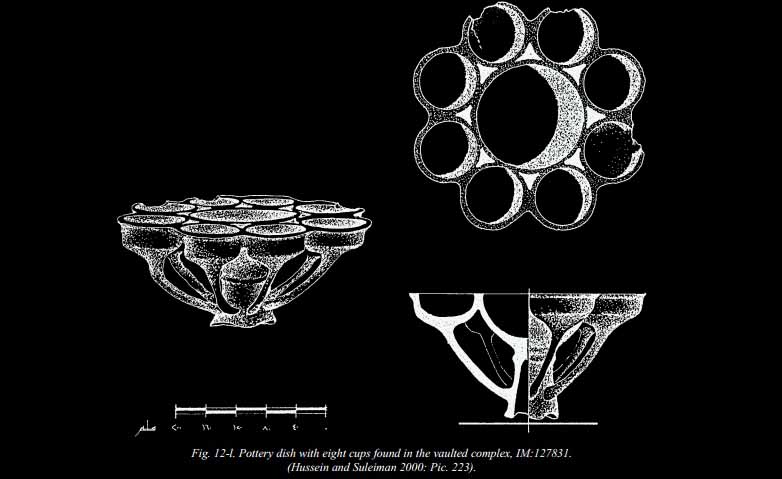
a reply to: Byrd
It's fine share any thoughts whenever.
It's a consideration based upon the Enki and Ninhursag myth were eight plants are grown relating to semen from Enki's relationship with the spider Goddess Uttu, who is a common motif of the seals.
She grew the 'tree' plant, she grew the 'honey' plant, she grew the 'vegetable' plant, she grew the esparto grass (?), she grew the atutu plant, she grew the aštaltal plant, she grew the …… plant, she grew the amḫaru plant. "My master, the atutu plant," he said to him, cut it off for him and Enki ate it. "My master, the aštaltal plant," he said to him, pulled it up for him and Enki ate it. "My master, the …… plant," he said to him, cut it off for him and Enki ate it. "My master, the amḫaru plant," he said to him, pulled it up for him and Enki ate it. Enki determined the destiny of the plants, had them know it in their hearts.
Enki eats the eight plants and freaks out and Ninhursag has to give birth to eight associated Deities from his afflicted body, the whole thing is weird even in mythological terms but the spider also related to Canis Major and medicinal practise.
It was also the case that the mystery schools generally preserved the tradition of eight plants and these could be represented through eight individual but connected bowls on the head of the presiding Goddess such as Cybele/Kubaba, see here on the kernos.
a terracotta vessel with many little bowls stuck on to it. In them there is sage, white poppy heads, wheat, barley, peas (?), vetches (?), pulse, lentils, beans, spelt (?), oats, cakes of compressed fruit, honey, olive oil, wine, milk, and unwashed sheep's wool. When one has carried this vessel, like a liknophoros, he tastes of the contents

a reply to: Byrd
It's fine share any thoughts whenever.
edit on Kpm930264vAmerica/ChicagoWednesday2130 by Kantzveldt because: (no reason given)
oil, like fine (?) oil, like oil of abundance, Nintur, mother of the country, like fine (?) oil, gave birth to Ninnisig.
the whole story seems like a recipe
maybe eight different stages for one substance ?
First he put his feet in the boat, next he put them on dry land. He clasped her to the bosom, kissed her, Enki poured semen into the womb and she conceived the semen in the womb, the semen of Enki. But her one month was one day, but her two months were two days, but her nine months were nine days. In the month of womanhood, like fine (?) oil, like fine (?) oil, like oil of abundance, Ninnisig, like fine (?) oil, like fine (?) oil, like oil of abundance, gave birth to
Its father is the sun, its mother the moon; the wind carries it in its belly,
there's a surprising similarity to alchemical practise
particularly
" like oil of abundance "
edit on 21-9-2016 by kibric because: Arutperumjothi
a reply to: kibric
Yes a recipe, a subtle balancing of ingredients, what the seven sages were noted for, and a very tightly controlled one seemingly given that it appears to have been lost and later generations were speculating and trying all sorts, perhaps a power struggle for control of production that went badly wrong and the secret was taken to the grave
Secrets of the Ante Diluvian sages
Yes a recipe, a subtle balancing of ingredients, what the seven sages were noted for, and a very tightly controlled one seemingly given that it appears to have been lost and later generations were speculating and trying all sorts, perhaps a power struggle for control of production that went badly wrong and the secret was taken to the grave
Secrets of the Ante Diluvian sages
edit on Kam930265vAmerica/ChicagoThursday2230 by Kantzveldt because: (no reason given)
originally posted by: zinc12
According to Russian archeologist Victor Sariandidi, “for the first time in the world archeological practice, monumental temples were found in which intoxicating beverages of the Soma-Haoma type were prepared for cult ceremonies? The excavations proved that poppy, cannabis and ephedra were used for making the Soma-Haoma drinks, and thickets of these plants were found in excess in the vicinity of the excavated temples of Margiana.”2
A slightly later but related site “revealed remains of ephedra again, but this time in conjunction with the pollen of poppies.” As Rudgley explains, “the discovery in the shrines of the remains of opium, cannabis and ephedra in ritual vessels that are dated between 2000-1000 BC show that Soma? may be considered as a composite psychoactive substance comprising of cannabis and ephedra in one instance and opium and ephedra in another.”
www.cannabisculture.com...
Just reading the original article from which that is extrapolated, I think that the first difficulty is that when Victor Sariandidi a great deal of research was obviously unavailable to him. He couldn't have known that then that papaver somniferum was first domesticated around the 5000BC mark around Iberia, most concentrated around Andalucia, but later found at Banderkeramik levels through northern and central Europe. At the time Sariandidi was writing, it was believed, due to the weight of the evidence, that the use of opium had originate in Greece or Anatolia, but that was because it was those people who were carrying the opium, as traders, into the meditteranean trade network, therefore, it was there that the product was being grown for export. The dates of the finds that Sariandidi made, which the article has somewhat manipulated, they were found in more of a temple offering, or perhaps even apothecary context, within the temple. They were not found blended, though the suggestion is made.
www.heritageinstitute.com...
The date of the find corresponds to the Minoan trade network. Carvings from Crete clearly attest to the importance of opium to their economic success. The Minoans were trading minerals through that region quite possibly with safe passage in exchange for opium. Opium has been found in similar contexts in Egyptian tombs which suggests, early in it's trade it was a high value novelty, tribute item. You give safe passage to the right people and soon you have to build a "temple" in order to show just how big your percentage is and in which to host the festivities when you get that tribute delivered. Such deals or alliances involve samples of the best of what you have to offer each other. Opium was presumably what was unique about the Western Mediterranean, which is supported by the pattern of finds, and the Bronze Age reach of the Minoan's produce, extensive due to the demand for tin and copper.
I don't think that, to date, any seeds or pollen, or finished opium for that matter, has been found further East in any context, until introduced by the British much much later that is. They have found papaver rosea, which was highly valued as a free boom crop, growing as a companion in cereal crops without any maintenance but yielding a useful oil, and nurtritious seeds. If opium entered into that region it would have been highly valued, rare, and it's use tightly controlled. If raw plants, or even dried seed heads, were being processed, you would expect to find pollen at least. I don't know if that level analysis has been done, perhaps the OP can shed some light?
new topics
-
Las Vegas UFO Spotting Teen Traumatized by Demon Creature in Backyard
Aliens and UFOs: 50 minutes ago -
2024 Pigeon Forge Rod Run - On the Strip (Video made for you)
Automotive Discussion: 1 hours ago -
Gaza Terrorists Attack US Humanitarian Pier During Construction
Middle East Issues: 2 hours ago -
The functionality of boldening and italics is clunky and no post char limit warning?
ATS Freshman's Forum: 3 hours ago -
Meadows, Giuliani Among 11 Indicted in Arizona in Latest 2020 Election Subversion Case
Mainstream News: 3 hours ago -
Massachusetts Drag Queen Leads Young Kids in Free Palestine Chant
Social Issues and Civil Unrest: 4 hours ago -
Weinstein's conviction overturned
Mainstream News: 5 hours ago -
Supreme Court Oral Arguments 4.25.2024 - Are PRESIDENTS IMMUNE From Later Being Prosecuted.
Above Politics: 6 hours ago -
Krystalnacht on today's most elite Universities?
Social Issues and Civil Unrest: 6 hours ago -
Chris Christie Wishes Death Upon Trump and Ramaswamy
Politicians & People: 7 hours ago
top topics
-
Krystalnacht on today's most elite Universities?
Social Issues and Civil Unrest: 6 hours ago, 8 flags -
Weinstein's conviction overturned
Mainstream News: 5 hours ago, 6 flags -
University of Texas Instantly Shuts Down Anti Israel Protests
Education and Media: 9 hours ago, 6 flags -
Supreme Court Oral Arguments 4.25.2024 - Are PRESIDENTS IMMUNE From Later Being Prosecuted.
Above Politics: 6 hours ago, 5 flags -
Massachusetts Drag Queen Leads Young Kids in Free Palestine Chant
Social Issues and Civil Unrest: 4 hours ago, 4 flags -
Meadows, Giuliani Among 11 Indicted in Arizona in Latest 2020 Election Subversion Case
Mainstream News: 3 hours ago, 4 flags -
Chris Christie Wishes Death Upon Trump and Ramaswamy
Politicians & People: 7 hours ago, 2 flags -
Any one suspicious of fever promotions events, major investor Goldman Sachs card only.
The Gray Area: 11 hours ago, 2 flags -
Gaza Terrorists Attack US Humanitarian Pier During Construction
Middle East Issues: 2 hours ago, 2 flags -
2024 Pigeon Forge Rod Run - On the Strip (Video made for you)
Automotive Discussion: 1 hours ago, 1 flags
active topics
-
Candidate TRUMP Now Has Crazy Judge JUAN MERCHAN After Him - The Stormy Daniels Hush-Money Case.
Political Conspiracies • 787 • : WeMustCare -
2024 Pigeon Forge Rod Run - On the Strip (Video made for you)
Automotive Discussion • 5 • : modusponus2 -
University of Texas Instantly Shuts Down Anti Israel Protests
Education and Media • 191 • : WeMustCare -
Supreme Court Oral Arguments 4.25.2024 - Are PRESIDENTS IMMUNE From Later Being Prosecuted.
Above Politics • 63 • : Annee -
Las Vegas UFO Spotting Teen Traumatized by Demon Creature in Backyard
Aliens and UFOs • 5 • : FlyersFan -
Thousands Of Young Ukrainian Men Trying To Flee The Country To Avoid Conscription And The War
Other Current Events • 139 • : Consvoli -
Is there a hole at the North Pole?
ATS Skunk Works • 39 • : Athetos -
The functionality of boldening and italics is clunky and no post char limit warning?
ATS Freshman's Forum • 11 • : JonnyC555 -
Nearly 70% Of Americans Want Talks To End War In Ukraine
Political Issues • 89 • : Xtrozero -
Gaza Terrorists Attack US Humanitarian Pier During Construction
Middle East Issues • 19 • : Consvoli
